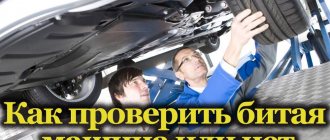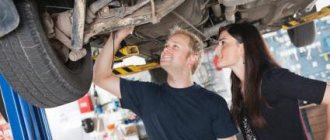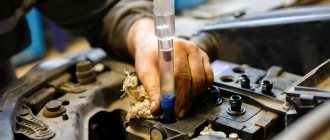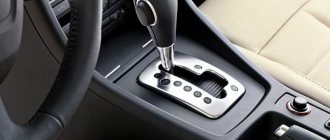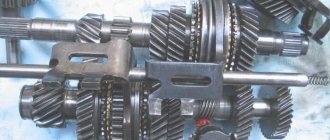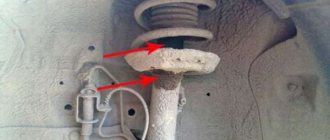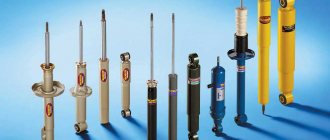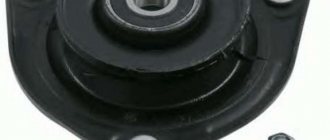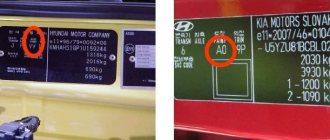The peculiarity of shock absorber wear is that it has a number of signs, and many drivers “wait” for the manifestation of only “their” signs that have long been familiar to them, ignoring others.
The nuance is also that an old shock absorber may work well in some conditions and not perform its functions in others.
Meanwhile, the importance of shock absorbers for traffic safety is great, because abnormally functioning struts lengthen the braking distance, impair the controllability of the car, and lead to skidding. Not to mention the fact that faulty shock absorbers mean impaired comfort and increased driver fatigue, even causing occupational diseases. So, the need to quickly replace the struts is signaled by several features of the car’s behavior - and they are easy to notice.
Breakouts
Shocks in the suspension when the wheel moves to its extreme upper and lower positions. These breakdowns occur even when moving slowly over large irregularities or, for example, when carefully driving off a curb - in contrast to “regular” impacts that mark the passage of large holes and bumps at high speed.
Rocking up
If, after passing a speed bump, the front or rear of the car makes several damped oscillations up and down, this is a reason to check the shock absorbers. The folk method is simple. You need to swing your hand, using your body weight, in turn, each corner of the car body. After the impact on the body stops, it should swing up and down no more than once. Otherwise, the corresponding shock absorber should come under suspicion, and you need to check it against other points of the algorithm given here.
Uncomfortable suspension operation
If, when driving over small irregularities, the wheels produce increased noise, we may be talking about wear on the shock absorber valve assembly (or two at once). This is not a metallic noise caused by a mechanical breakdown of the shock absorber, but rather stronger impacts of the wheels on the edges of the pit.
Drips
Abundant traces of liquid on the shock absorber body are a harbinger of an imminent replacement of the struts. Light "fogging" is allowed.
A quick and almost error-free verdict regarding the replacement of struts can be given by diagnostics on a special stand, which, based on the amount of damping of suspension vibrations, determines the residual efficiency of shock absorbers. Today there are such stands at many service stations.
If you find an error, please select a piece of text and press Ctrl+Enter.
Many front-wheel drive cars use MacPherson struts as front independent suspension.
Like any suspension, the main purpose of these struts is to dampen vibrations and vibrations and reduce their transmission to the car body.
The important role of MacPherson struts
But MacPherson struts have another important function - they also serve as steering knuckles. That is, the stand with the wheel hub attached to it can rotate around an axis, which allows the drive wheels to be steered.
Naturally, where there is rotation, a bearing is used; in the case of this type of suspension, a support bearing.
To figure out where the support bearing is installed, let's briefly look at the car suspension structure.
Its main components are:
All these elements are assembled into a single whole, which provides the possibility of compressing and decompressing the spring and moving the shock absorber rod in the body (which is what the suspension is actually for, since vibrations are damped during these movements).
To ensure all this, the rack is assembled like this: a shock absorber is installed in the body and all this is installed in a spring.
To support the spring from below, a cup is used, attached to the body (welded to it).
To ensure that the spring is pressed, another cup is installed at the top, which rests against the support.
The spring extension limiter is the shock absorber rod, the end of which passes through the support and is secured with a nut.
Additionally, the support not only acts as a stop for the spring, it also provides the upper fastening of the strut to the body (it is attached to it with levers from below).
Additional inspection
If, upon inspection, the shock absorber body is dirty or has traces of an anti-corrosion agent, then this seriously affects its service life, because during intensive operation of the suspension a large amount of thermal energy is released. And contamination of the shock absorber prevents the dissipation of high temperatures in the body. We also inspect the shock absorber for any deformation in its body. Irregularities in the housing can create increased friction during the piston stroke. Next, we pay attention to the rod in the piston, since the curvature of the rod can lead to jamming of the suspension while the car is moving, which is extremely dangerous for the life and health of the driver and passengers. If, during an external inspection of the shock absorber, you find scratches, areas of corrosion, and uneven chrome coating, then all this can cause depressurization. Unfortunately, due to unskilled installation, we can often observe mechanical damage to the shock absorber. A leaking shock absorber cannot perform its functions, so it must be urgently replaced with a new one.
Where is the support bearing installed and what function does it serve?
It is noted above that the MacPherson strut also acts as a steering knuckle. From below, rotation around the axis is ensured by a ball joint, through which the levers are attached to the rack.
If the upper strut support were not a limiter for the spring, then there would be no problems with rotation (the shock absorber rod can rotate freely).
But the spring, being in a preloaded state, creates a fairly strong force on the cups, and as a result on the support, which is rigidly attached to the body.
Therefore, a support bearing is installed between the support and the upper spring cup.
Thanks to this design solution, under the influence of the steering mechanism, the stand (assembled) can rotate around the axis, while the support remains motionless.
It is precisely the support bearing that provides the ability to rotate the shock absorber strut.
Types of bearings
There are two design versions of the upper part of the rack:
- The support bearing is included in the support design (can be found on a number of VAZ models);
- It is a separate element that is placed between the support and the upper spring cup.
But there are several support bearings themselves that are used in the suspension design:
- WITH BUILT-IN OUTER OR INNER RING. Its peculiarity lies in the possibility of rotation of elements that are in contact with both the outer and inner rings. Additionally, this option provides installation holes, so no pressure flanges are needed during installation;
- WITH DETACHABLE OUTER OR INNER RING. In this embodiment, one of the rings (depending on the design) can be separated, while the second is fixed to the support;
- SINGLE-SPLIT. Structurally, this option is the same bearing with a detachable ring, but has increased rigidity.
see also
How to check a support bearing
- 111 1 194k
Strut support bearing
Which shock absorbers are better
- 159 3 148k
How does a car's shock absorber work?
Shock absorber (car shock absorbers)
Shock absorber malfunctions greatly affect the car's behavior on the road. In particular, the car body “dives” during acceleration and braking, the braking distance increases, rolls heavily during maneuvering and sways when driving over uneven surfaces.
There are obvious and hidden signs of faulty shock absorbers. Obvious ones include the appearance of oil leaks (wear of the oil seal and/or rod), but there are more hidden ones, for example, aging of the oil, deformation of the valve mechanism plates, wear of the piston seal and the inner walls of the working cylinder. To avoid unpleasant consequences, you need to identify the faulty shock absorbers in time.
Consequences of bearing wear and signs of damage
Since the support bearing can be partially attributed to the steering (without it, rotation of the rack would be impossible), its failure primarily affects the controllability.
But here it should be noted that this depends on the design solution used.
For example, in a VAZ-2110, the inner race of the bearing acts as a bushing through which the shock absorber rod passes.
As a result of critical wear of the bearing, it begins to play and the rod is able to deviate from the axis.
The result of this is a violation of the wheel alignment angles, and consequently a deterioration in the car’s handling, as well as accelerated tire wear.
But on a car, where the bearing only provides rotation of the strut and does not interact with the shock absorber, alignment violation practically does not occur, since the rod is kept from axial displacement by a bushing pressed into the rubber damper.
But even with this design, bearing wear will have a negative impact on handling.
If the bearing has worn out, this will naturally begin to show. In this case, the symptoms of a malfunction depend on the design.
If we take the same VAZ-2110, then bearing wear will manifest itself in the form of knocking noises when driving over potholes and unevenness on the road; in addition, they can be heard when turning. Sounds in the support are caused by play in the support element; it is important not to confuse them with a knock in the shock absorber.
In the case of a bearing that does not interact with the shock absorber, its malfunction most often manifests itself in the form of squeaks and squeaks when turning.
How to test new struts
It is very important to monitor the condition of the vehicle and know how to check the shock absorbers, since they are the ones that keep the car in the correct position on the road.
If this important suspension element fails, and the car owner postpones testing the shock absorbers until later, the accompanying chassis parts will also be susceptible to failure:
- Failed shock absorbers, coupled with wheel imbalance, will lead to accelerated tire wear and destruction of wheel bearings;
- After traveling several thousand kilometers with faulty struts, the support bearing will break down;
- If the shock absorber is in good working order, the service life of the brake pads increases, but when there are problems, the braking system is no longer reliable, since the braking distance increases and the likelihood of an accident increases.
So it turns out that timely intervention can protect not only from various breakdowns and traffic accidents, but will also significantly save the car owner’s budget - after all, it is cheaper to replace struts at the stage when the first signs of a malfunction appear than to repair the chassis or brake system later.
If you decide to do your own diagnostics, then use these tips on how to check shock absorbers at home:
- Drive the car into the pit and carefully inspect the shock absorbers for oil leaks, body deformation or contamination.
- Pay special attention to the piston rod; if it is damaged, the system may depressurize.
- While driving, listen to see if there is a knocking sound in the car’s suspension.
- Inspect the tire tread; if it wears unevenly, it may be time to replace the shock absorbers.
- Go through the same turn several times at the same speed and pay attention to whether the car skids; if so, it means the shock absorber is faulty (only for experienced drivers who have studied their car!).
It is not always possible to determine a breakdown without removing the element. However, there is a way that allows you to find out the problem at a professional level. How to check shock absorber struts without dismantling them? To do this, the car is driven onto a vibration stand. The cost of the service starts from 1 thousand rubles. At the same time, not only shock absorbers are checked, but also other suspension components, as well as the braking system.
If you cannot be completely sure of the correctness of your conclusions about the proper operation of the shock absorber struts, contact specialists who will perform diagnostics on a vibration stand. Of course, you will have to pay some money for this, but thanks to the test at the stand, you will be able to get an expert opinion and precise instructions for action. If, of course, you contacted a trusted car service center.
To avoid wasting your money, follow these simple guidelines:
- Check whether the technicians have configured the computer to diagnose exactly your make and model of car (the settings are individual for each car);
- It is necessary to take into account the age of the car, since the weight of the body changes over time, so the settings and standards will have certain deviations;
- Before bench testing, check your wheel alignment and tire pressure;
- Go only to a reputable service.
Checking shock absorber struts is not at all as simple as it seems; it is a troublesome and time-consuming process, where you need to take into account every detail, every little thing.
The options discussed above are how to check shock absorbers on a car with your own hands, that is, in a garage. Taken together, they are quite effective and allow you to calculate the faulty node with fairly high accuracy. If you don’t have time for self-diagnosis or you can’t accurately identify the defect, it’s better to contact a service station.
As a rule, car services have a device for checking shock absorbers - a special stand. Its advantage is the ability to test all the main parameters and get an accurate picture of the condition of the components.
This test is an opportunity to test the damping force and obtain a complete picture of axial vibrations.
Upon completion of the tests, specialists announce the exact results and tell you what to do next - continue driving the car or immediately replace it. The main disadvantage of this method is the high price and complexity of implementation. In addition, not all service stations offer such modern equipment.
Please note that driving on faulty shock absorbers is dangerous. At the very first sharp turn there is a risk of capsizing, losing control of the car and flying into a ditch.
So it’s better not to tempt fate, check the shock absorbers in a timely manner and replace faulty elements. Good luck on the roads and of course no breakdowns.
Verification methods
Checking the condition of the support bearing is not difficult, but the technology depends on the design features of the rack itself.
It is worth noting here that such a check will not give an accurate result; you can verify that the bearing is faulty only after removing it from the car.
But, nevertheless, by performing a number of simple steps you can determine the condition of the upper support.
If we take the VAZ-2110 model, then its support bearing is installed in the support itself.
To check its condition, you should ask an assistant to rock the car in the transverse direction (not too much), while at this time we place our hand on the protruding part of the pillar in the engine compartment.
If the bearing is worn out, play will be felt by hand. Also, in a damaged element, such rocking is usually accompanied by the appearance of third-party sounds - creaks, clicks.
If all this is found during the inspection, it’s time to inspect the support.
On models such as Lada Priora, Lada Kalina, or, for example, Nissan X-Trail, the bearing is not included in the support structure, so it cannot be checked by rocking it. The only sign of wear for them is the appearance of a knocking sound when moving.
But it is still possible to further verify that the unit is faulty.
To do this, ask an assistant to turn the steering wheel in different directions. At the same time, we put our hand to the spring.
If the bearing is heavily worn, then wedging may appear in it, which will be reflected well into the spring in the form of vibration and mild “shooting”.
Signs of a faulty shock absorber
Faulty and worn shock absorbers entail a lot of other problems; let’s look carefully at the signs by which you can directly determine the malfunction of car shock absorbers:
Visual signs of shock absorber failure:
- Deformation of the cylindrical body. A deformed shock absorber body can completely or partially jam the piston inside it. As a result, the shock absorber jams;
- Oil leaks directly from the shock absorber. Oil leakage reduces the extinction rate;
- Deformation or loosening of fasteners. With a high probability, if this problem is ignored, the fastenings will be destroyed;
- Damage (deformation, cracks) of mounting bushings. Damaged bushings are highly likely to result in noise that occurs when driving on uneven surfaces and accelerating;
- Damaged shock absorber piston. Significantly increases tire wear;
- Piston rod corrosion. Increases wear on oil seals, resulting in oil leakage;
- Spring support corrosion. With a high probability, as a result of corrosion, the spring plate may come off.
In addition to the visual signs listed above, the following may also indicate a malfunction of the shock absorbers:
- Increased tire wear;
- Significant “squatting” of the front of the car when braking;
- Significant “squatting” of the rear of the car during acceleration;
- The car skidding when turning;
- Rocking (left, right) of the car while driving;
- Increased shaking of the car when driving;
- Poor adhesion of the car wheels to the road surface;
- Suspension breakdown;
- Reduced vehicle controllability at speeds over 80 km/h.
Bearing replacement
No matter what kind of car the support bearing wears out, but if it uses a MacPherson strut, then the technology for disassembling the unit for replacement is identical, with the exception of some nuances regarding the suspension design.
Therefore, we will consider how replacement is carried out on a VAZ-2110 car, and then we will indicate the features of the operation on other models.
So, it has been revealed that the support bearing requires replacement. All work can be done in a garage, but some specialized tools will be required.
In general, you will need:
- Standard set of keys, hexagons, heads with collars and rods;
- Jack;
- Steering wheel end remover;
- Spring ties;
- Rags.
A new support will also be required, since on this car the bearing is included in its design.
Of course, you can disassemble the support itself to replace only the bearing, but most car owners prefer to replace the entire assembly.
Why is it so important to monitor their condition?
The resource of this mechanism is about 60 thousand kilometers. This figure largely depends on the condition of the road surface. The shock absorber does not always maintain this specified period. It can fail at any moment. Therefore, you need to be guided not by the regulations, but specifically by the state of these damping devices.
Why is it so important to monitor their condition? A faulty shock absorber can lead to wheel imbalance. As a result, the tire will wear unevenly. The car will skid at speed. Also, a faulty shock absorber reduces the life of the wheel bearings. They are quite expensive. But on many cars this unit is assembled with the hub. Therefore, the cost of repairs can be up to 20 thousand rubles.
How to determine when it's time to change the struts? Signs of wear
Since disassembling a car's suspension is quite a labor-intensive task, before you undertake repairs, you need to determine whether the problem is really in the strut. To do this, you need to focus on the following indirect signs:
- A strong beating is felt on the steering wheel of the car.
- Body vibration increases significantly. Particularly strong vibration comes from the side of the faulty rack.
- The car begins to stop worse when braking.
- When turning, the car starts to skid.
- If you let go of the steering wheel on a flat road, the car will drift strongly to the side.
- Even with a visual inspection, you can notice oil leaks on the shock absorber.
- If you ask someone to drive slowly and listen yourself, you can hear strange knocks and noises in the shock absorber, which is under suspicion.
Signs of failure of the front struts on a VAZ-2110
Basically, machine diagnostics are carried out in a car service center using computer technology, but experienced private technicians can also determine what’s wrong.
The driver should constantly listen to the operation of the suspension, and if there is the slightest doubt about its correct operation, contact a service center.
At least a couple of times a month, conduct a simple test with the help of an assistant. Choose a deserted road and accelerate well, then turn the steering wheel; your friend should be watching the trajectory of the car all this time. If the VAZ-2110 begins to skid, and the movements become chaotic, as if it is difficult for the driver to control the vehicle, then it is time to begin a qualified diagnosis of the front pads.
The danger of worn struts
Some car owners believe that failure of the front shock absorbers is not a problem, especially if the car does not even tilt to one side. In fact, problems with the front suspension can lead to the following troubles:
- The support bearings will fall apart, which can lead to an accident.
- The tires will begin to wear unevenly, and you can forget about wheel alignment. In addition, so-called “bumps” may appear on the tires.
- Wheel bearings won't last long either.
- Brake performance will become unsatisfactory because the pads will wear unevenly.
It turns out that one problem that is not corrected in time can lead to serious damage to the car.
Diagnostics of shock absorber struts
If there is even the slightest suspicion of a malfunction, it is necessary to urgently carry out diagnostics. How are shock absorbers checked? There are a number of activities that the car owner can carry out independently, which will become the initial testing of the rack.
Some car enthusiasts prefer to do without testing at the stand and begin to rock their car themselves to determine the wear of the shock absorbers. However, such a check is not very informative, because if the racks are already weakened but functional, rocking will show that everything is in order, but this is not the case.
Which ones to choose (items)
In the case of spare parts for the VAZ-2110, original consumables are not always the best choice. As for the most popular shock absorbers, they have the following article numbers:
- The front left shock absorber on the VAZ-2110 has article number 21100-2905403-30;
- Right - article number 21100-2905402-30.
The article number is stamped on the rack body.
Factory analogues can be recommended to those drivers for whom rigidity indicators are important. It is the original A-pillars that do an excellent job of transporting cargo, although for comfortable movement in the city they are clearly inferior to their softer counterparts.
Some drivers install sports struts that are significantly more rigid than even the factory parts. So they are trying to increase the life of this suspension unit. In any case, it is not recommended to install sports spare parts, since they are designed for completely different operating conditions.
Some people praise Samara spare parts, which are known as SS-20. They can be either oil or gas. Oil shock absorbers are much cheaper, but gas shock absorbers can operate over a wider temperature range. For example, in winter the rigidity of cheaper parts will increase significantly, although for some car owners this does not matter.
Front struts SS-20 series “Comfort” assembled.
When to change a shock absorber
It is necessary to understand that regardless of the quality of the shock absorber, as well as the operating conditions of the machine, wear of this unit occurs constantly. With more or less speed, but constantly! Accordingly, their condition also needs to be checked constantly. Most shock absorber manufacturers in the mid-price category recommend checking every 20...30 thousand kilometers . As for replacement, usually the shock absorber wears out significantly after approximately 80...100 thousand kilometers . At this stage, you need to check it more thoroughly and, if necessary, replace it.
To ensure that shock absorbers last as long as possible, follow these recommendations:
- Do not overload the machine . The manual for any vehicle directly states its maximum load capacity. You should not overload the car, because this is harmful to its various components - including the engine and suspension components, in particular shock absorbers.
- Let it get into working mode . When driving a car in the cold season (especially during significant frosts), try to drive the first 500...1000 meters at low speed and avoiding bumps. This will allow the oil to warm up and spread.
Thus, if problems arise with the shock absorbers, it is better not to tighten it and replace the problem units with new ones. As for the purchase, it is better to buy licensed shock absorbers from the “officials”. Or choose products in trusted stores based on reviews from car enthusiasts.
Analogs
In addition to domestic parts, you can install front struts from other manufacturers, which will cost much more:
Although installing expensive parts on domestic cars is not always economically justified, some people prefer to spend a large sum once, but then do not have to worry about replacement for several years.
Aston racks are another analogue of domestic production.
Front shock absorber replacement procedure
Before you begin the front suspension repair procedure, you need to prepare the necessary set of tools. In addition to the standard set of wrenches and screwdrivers, you will need a device for compressing the springs on the struts and a special puller for ball pins. It is advisable to have WD-40 liquid, since rusty and rooted bolts will definitely be encountered during the repair process.
The replacement process will proceed as follows:
- First, the nuts that connect the support to the body cup are unscrewed.
Using a 13 mm spanner, unscrew the nuts securing the upper support.
- The supports are released.
- The rod ends are removed. To do this, it is advisable to use a special puller.
We take out the cotter pin.
Unscrew the nut.
Press out the finger.
- The lower part of the strut is disconnected from the steering knuckle.
We unscrew the nuts of the bolts with a head of 19, then knock them out.
- The stand is removed and replaced with a new one.
Pull back the fist and remove the stand.
Before releasing the rod, you need to compress the shock absorber spring. It’s better to immediately fill the ball pin with Vedashka, since it will be very difficult to remove it without a special puller, and a VD-40 puller won’t hurt.
To compress the springs we use special ties.
Wheel alignment, is it necessary?
Many VAZ-2110 owners are interested in whether it is necessary to do a wheel alignment after replacing the front strut. This procedure is optional only when replacing the rear struts.
When replacing front shock absorbers, wheel alignment is a mandatory procedure.
You can replace the strut yourself, but to adjust the wheel alignment you need to go to a service center.
